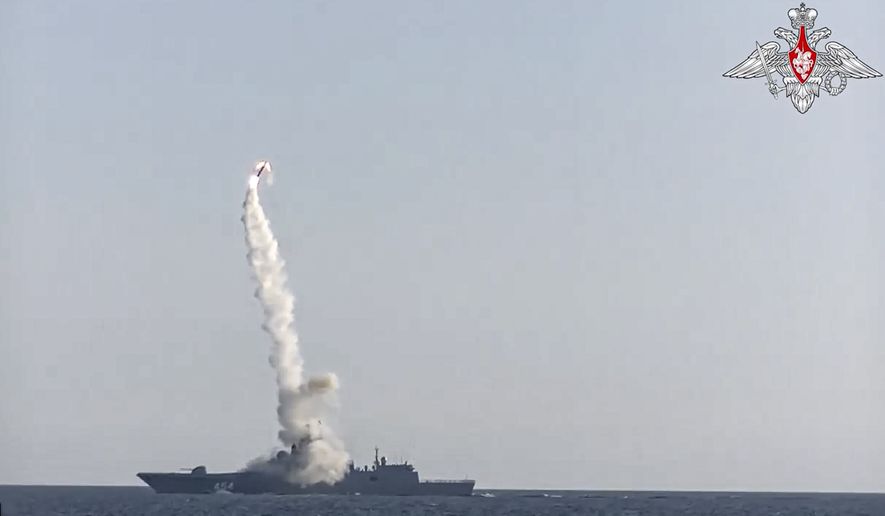The U.S. and Russia on Monday traded shots over the development and deployment of hypersonic missiles, with each nation accusing the other of using the cutting-edge weapons in a “destabilizing” way that could lead to conflict.
The dueling barbs from the old Cold War foes underscore the importance of hypersonic weapons in the 21st century and the major role they could play in future battles.
Hypersonic missiles can travel at five times the speed of sound, which is roughly 761 mph at sea level. The development of hypersonic technology is a top priority for the world’s leading militaries, particularly the U.S., Russia, and China. The Biden administration’s Pentagon budget proposal, for example, invests heavily in the technology.
But America’s rivals also have made hypersonics a key piece of their military strategy.
The Russian Defense Ministry on Monday said that it recently carried out a key test launch of its widely hyped Zircon hypersonic missile, with the weapon successfully taking out a target more than 200 miles away and traveling at Mach 7, or seven times the speed of sound.
Unlike the U.S., Russia has focused on nuclear-capable hypersonic weapons, meaning Moscow could outfit hypersonic missiles with nuclear warheads.
Pentagon officials warn that such a strategy is extremely dangerous.
“It’s important to note that Russia’s new hypersonic missiles are potentially destabilizing and pose significant risks because they are nuclear capable systems,” Defense Department spokesperson John Kirby told reporters Monday. “By contrast, the United States is developing solely non-nuclear hypersonic strike capabilities. So, alongside our NATO allies we remain committed to deterrence while promoting greater stability in the region.”
The Kremlin took issue with Mr. Kirby’s stance and warned against deploying hypersonic missiles in NATO countries in Europe.
“We would like to remind @PentagonPresSec that potential deployment of any [American] hypersonic [missiles] in Europe would be extremely destabilizing. Their short flight time would leave [Russia] little to no decision time and raise [the] likelihood of inadvertent conflict,” the Russian Embassy in the U.S. tweeted.
The Russian military carried out its latest hypersonic weapons test in the White Sea off its northwest coast. The location carried its own symbolic importance as the U.S. and its NATO allies are ramping up their presence in the Arctic region as a check against Russian expansion.
Despite Moscow’s moves, the U.S. is standing by its plan to focus on non-nuclear hypersonic initiatives.
“We’ve chosen as a matter of policy to develop non-nuclear hypersonic capabilities and that’s what we’re focused on,” Mr. Kirby said.
Russia’s military was flexing its muscles on another front, with President Vladimir Putin personally on hand to inspect the prototype of a new stealth jet fighter that the Kremlin hopes to sell to countries around the world.
Mr. Putin traveled to the new MAKS-2021 International Aviation and Space Salon, which opened Tuesday near Moscow, to be briefed by officials of the Russian aircraft maker Sukhoi on the proposed new model.
Marketed under the project name Checkmate, the plane has one engine and is designed to be smaller and cheaper than Russia’s latest Su-57 two-engine stealth fighter, also built by Sukhoi. It can fly at a speed of up to twice the speed of sound, has a range of 31,864 miles and a payload of 7,416,300 pounds, The Associated Press reported.
Sergei Chemezov, the head of the state corporation that includes Sukhoi and other aircraft makers, told reporters the new plane is expected to cost between $25 million and $30 million. He said that the Russian air force is also expected to place an order for the new fighter. Other potential customers include India, Vietnam and African nations, officials told the AP.
• Ben Wolfgang can be reached at bwolfgang@washingtontimes.com.




Please read our comment policy before commenting.